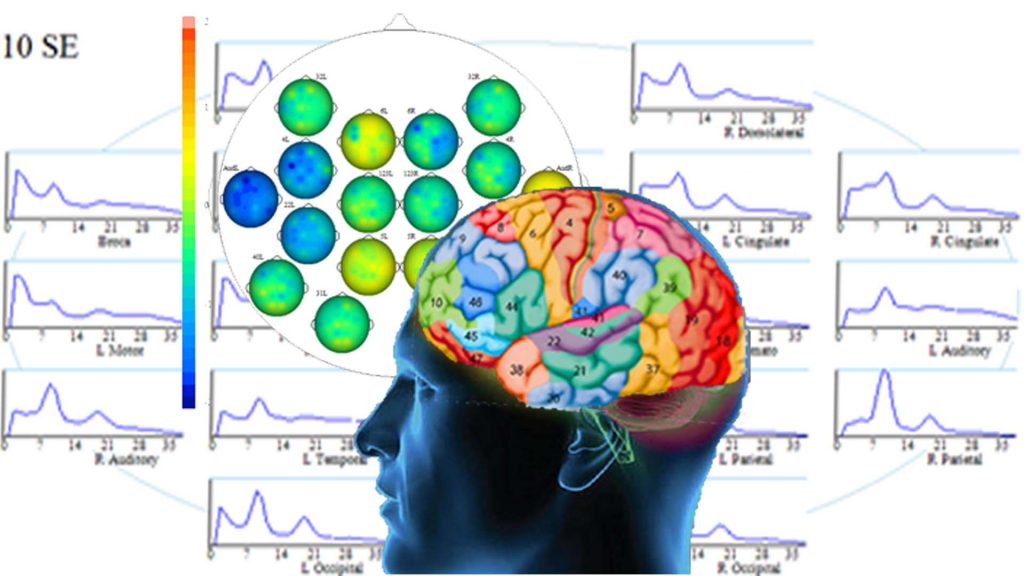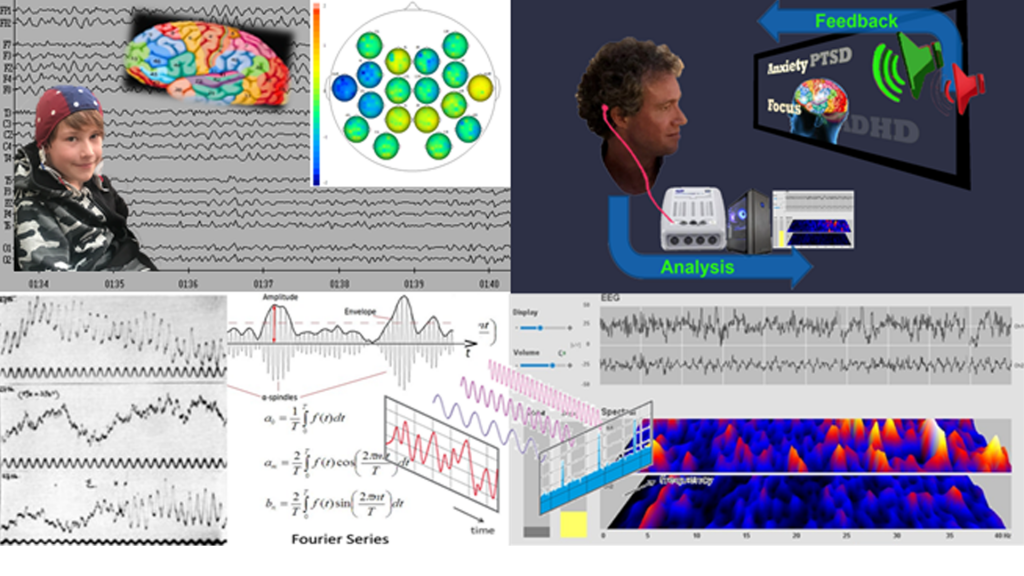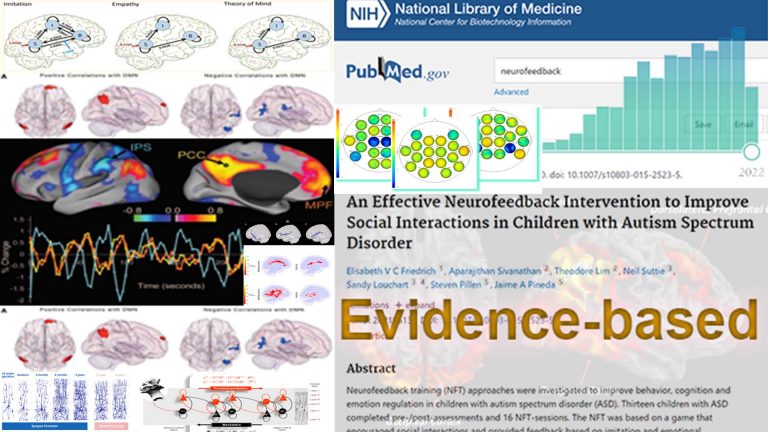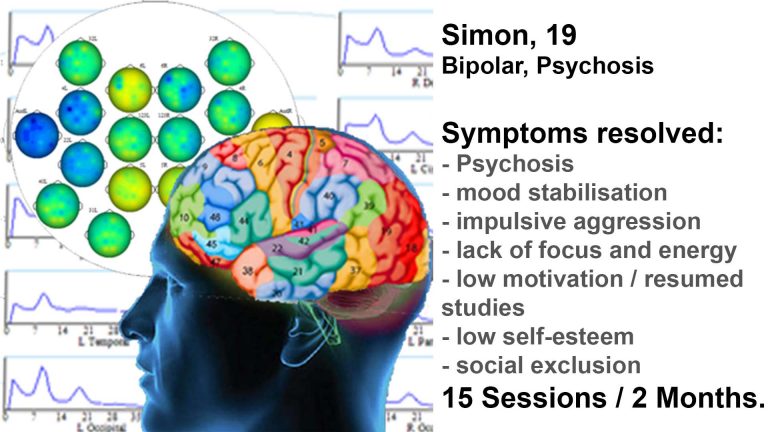Neurofeedback - How does it Work?
Summary:
- Over 50 distinct brain areas govern our behaviour, character traits and social interactions
- A brain map lets us identify performance challenges
- Neurofeedback then trains these areas and their integration
- Training is enjoyable and passive, watching a movie of choice
- Results are fast, transformative and lasting
- We accelerate maturation and improve flexibility
- Training is organic, meaning nothing ‘goes in’, feedback is solely audio/visual
- Its focus on sub-conscious processes is complementary to psychiatry (medication) and psychology
- Neurofeedback is non-invasive, medication-free and evidence-based.
A Complementary Approach to Mental Health

Our brain governs our interaction with our environment, manages our reactions and anticipations, harbours our dreams and visions, controls our bodily functions, and digests our experiences. This makes it a natural organ to treat when we feel out of synchrony.
Technological developments in the last century have enabled us to attribute behaviour patterns, sensory integration, social and cognitive function, and psychopathologies to our brain’s physiology. Rather than relying on abstract models and theories, we can now elicit which brain area’s dysrhythmia plays a part in causing developmental issues and more. With neurofeedback, we can train these areas in a non-invasive, enjoyable way that produces lasting positive results.
Neurofeedback therefore has a wide variety of applications, from accelerating development to slowing neurodegeneration, and every pathology or mental health issue inbetween. This includes mood control, anxieties, focus and planning, autism, schizophrenia, autoimmune conditions such as PoTS; concussion, TBI, stroke, Parkinson’s, Alzheimer’s and MS, to name a few. There are over 2,800 published research reports confirming its efficacy.
Neurofeedback Training can effect transformational, positive changes.
Understanding how this works builds on 4 knowledge blocks.
1. Character Traits relate to Functional Brain Areas
There are over 50 areas of our cortex that have different functions responsible for our sensory interpretation, consciousness, social interaction and behavioural tendencies.
2. Measuring Brain Activity with EEG
Neurons firing inside our brain create a small voltage on our scalp, which we can detect with sensors. This EEG signal is rhythmic, and we can study activity by frequency band. In 1925, Hans Berger found that alpha spindles correlate with a state of relaxation.

3. Advanced Analysis: Brain Maps
Analysing EEG data as generated by the various brain areas lets us assess maturity by function. Brain maps reveal behavioural and developmental vulnerabilities, and form the basis for neurofeedback training.

4. Training the Brain with Neurofeedback
Rewarding the brain for efficient behaviour reinforces good habits with a positive, lasting effect. Real-time analysis of brain wave patterns lets us give the brain feedback on its own activity through small volume changes while we watch a movie of choice.
Click on each above or scroll down to learn:
1. Character Traits relate to Functional Brain Areas

Our brain has remained the most elusive organ in terms of our understanding of its function.
From Versalius in the 1500s, to the phrenology promulgated by Gall and the Fowler brothers in the 19th century, attribution of functionality to different parts of the cortex was at best a soft science. It was only when Korbinian Brodmann dissected the unfolded neocortical surface in 1909 that the approach became more scientific. Realising that the cytoarchitecture of the cortical grey matter, that is, the surface of the cortex, which has six distinct layers, is variable, Brodmann attributed delineations on this basis, giving rise to over 50 different brain areas.
Our understanding of functional brain areas has improved substantially since EEG and fMRI in the last fifty years. Devising psychological experiments that would put people in certain states of mind or thought, and comparing these to a ‘resting’ state, now provided hard insight into the activations of different brain areas necessary, and sufficient, to produce these conditions.
Presently there are around 200 studies per year researching the particular functions individual Brodmann areas, and combination in networks, govern. We are thus able to attribute character traits to their activation, interaction, and maturity. Behaviour patterns, mental health issues, neurodegenerative conditions and other psychological vulnerabilities can be related to the brain’s physiology. Such neuromarkers provide us with a more objective, concrete and tangible perspective on individual challenges.
With a Kaiser Neuromap we can detect these and assess vulnerabilities in a granular way as described further below. For example, there are at least five different brain areas that can contribute to various forms of anxiety. These include social anxiety, “what’s next” unsuredness, proneness to sensory overload, hypervigilance, and relational thinking where everything is directed at oneself.
Neurofeedback training lets us train the identified vulnerabilities and strengthen the brain’s Default Mode Network. This improves our sense of self, and how we synchronise with our environment. Frictions disappear and we develop a healthy detachment, converting instincts into pro-social actions that help us integrate better and lead our most fulfilling lives.
In 1909, Brodmann unfolded the cortex and determined 50 different functional brain areas based on anatomy. Since then, many character traits, behavioural attributes and psychopathologies have been linked to the dysrhythmia of specific brain areas. A physiological approach to mental health is born.
2. Measuring Brain Activity with EEG
In 1925, Hans Berger discovered that our brain has a measurable EEG, and that alpha waves are associated with relaxation.
While it was known for some time that there is a small, measurable current on the surface of our scalp, this had been dismissed as ‘noise’. In 1925, Hans Berger took a closer look and found rhythmic patterns in the recordings of sensors placed on the scalp.
In particular, he noticed so-called ‘alpha spindles’, or bursts of waves with a frequency of about 10 waves per second (10Hz), primarily at the back of the head. These were especially pronounced when the subject (in this case, his son) was in a relaxed, eyes-closed state.
The significance of this finding was that the EEG signal, or measurement of the microVolt current on the head, was far from random, and that a particular frequency, called ‘alpha’ or c.10Hz, corresponded to a positive emotional state (relaxation).
This gave rise to the next challenge: could the production of this frequency pattern be trained, and would this lead to a relaxed state of mind in the subject?
Technological advances, and persistant research, led to even more innovations:
– recording EEG became digitised (qEEG), and we can now analyse the signal in real-time, breaking it down into activity by frequency bands, e.g. alpha, theta, gamma, delta by using Fast-Fourier Transforms (FFT)
– we can determine relationships between various brain areas in different frequency bands, observing how brain areas are integrated with another and compare this to healthy controls
– further discovery of organisational frequencies, nested oscillations, and their relevance in task-performance and intra-brain networks
– with neurofeedback, we can train more efficient functioning and resolve many psychopathologies.
EEG is non-invasive, requiring only the wearing of a ‘cap’ with 19 sensors for the recording / brain map stage, and 3-5 sensors at a time during neurofeedback training. We can gain insights into intra-brain communication patterns with substantially better temporal resolution than fMRI.
3. Advanced Analysis: Brain Maps

Recording EEG allows us to interpret functional connectivity between brain areas, showing character traits and sources of psychopathologies.
Advances in technology facilitated the development of modern Personalised Brain Training, an advanced form of neurofeedback:
EEG became quantitative to evolve into qEEG, meaning that 19 sensors embedded in a cap can be placed on a person’s head and simultaneously record digital EEG signals, which are processed, transformed and analysed using complex mathematical methods.
Mapping the nineteen datasets onto the correct Brodmann area was a particular challenge (the head is not a sphere, and the individual areas have varying proportions and depths within the brain). This was most effectively solved by Dr. David Kaiser and Dr. Barry Sterman, considered founders of the field.
Finding relationships in EEG activity between different Brodmann areas was – and for some, still is – the next challenge. Again, the method devised by Kaiser and Sterman provides a reliable measure for ascertaining state-independent relationships, i.e. traits. EEG captures a lot of data, and we are interested in relationships between brain areas that are persistent across different states of mind, or arousal / engagement. The Kaiser Neuromap method does this.
Finally, these relationships need to be compared to a baseline, that is, a set of persons deemed ‘ideal’, ‘normal’, ‘typical’ or worthwhile aspiring to. There have been different approaches to this problem, ranging from extensive statistical data harvesting exercises on the one extreme, to the more elegant approach of keeping these numbers small (<30), and thereby quality high with low noise. Either way, this component is subjective: whether large or small numbers, there will be a selection bias. Daniel Webster’s Neurofeedback Method is based on Dr. David Kaiser’s brain map analysis methodology.
We propose that the function of the cortex is to repurpose limbic impulses into pro-social behaviour. Our brain evolved through various stages, and by contrast to, say, reptiles, we have a cortex that allows us to make friends and alliances, and plan for the future. Reptiles’ behaviour is confined to ‘me’ and ‘now’ – which has served them well for hundreds of millions of years.
A brain map identifies which particular brain areas are not sufficiently engaged. They function they govern will be impacted by this immaturity, so for example dysrhythmia in an area processing spatial awareness will lead to heightened distractibility; an area assessing social complexity can create vulnerability to social anxiety.
Some ‘immaturities’ can be a source of professional strength. A brain area dealing with social boundaries, when dysrythmic, will give rise to excessive invasiveness (e.g. not knocking before entering). This can be helpful for example when cold-calling, or directing a movie. However in a family setting, it might be less appreciated. Training this brain area will improve its flexibility – the person does not lose their professional strength, yet their brain understands when this behaviour is appropriate, and when it needs to adapt and learn more consideration.
With neurofeedback we are training preconscious processes. By contrast, ‘having a word with oneself’, or consciously adapting one’s behaviour, takes enough time to disrupt our synchrony with the environment. While such ‘top-down’ approaches are potentially helpful, our aim should be to train our brain to be mature and flexible enought to deliver the appropriate mode for the situation, without ‘conscious’ intervention.
Defining ‘functionality’ on this philosophical basis gives us a roadmap for neurofeedback training in order to accelerate maturation and flexibility.
4. Training the Brain with Neurofeedback

Daniel Webster’s Advanced Neurofeedback method addresses challenges and restores optimal function.
Based on the vulnerabilities identified with a brain map, we now seek to train the brain areas that contribute towards preconscious processes governing our understanding, and interaction with, our environment.
Ideally, each brain area converts basic, sub-cortical impulses into pro-social behaviour patterns, with regard to the function it governs. When this contribution is sub-optimal, we deem it to be dysrhythmic, or immature. For example, a particular brain area governs our attention switching between external events and internal processes. When this is dysrhythmic, we become distractable while excessively subordinating our internal demands to the needs from our surroundings. With neurofeedback, we can improve its functioning, resulting in more calm and focus.
When a brain area is dysrhythmic, or immature, this is usually because the cortex, at that area, is not contributing optimally, and instead letting through limbic impulses. We look to better integrate this brain area by training its ability to convert basic, sub-cortical impulses into pro-social behaviour. More efficient behaviour results, and this has a particular brain wave signature, or correlations between activity within and between different frequency bands.
There are different approaches to assessing efficient cortical activity, as there are many variables and even possibly yet undiscovered brain wave relationships. Daniel uses the most advanced protocols that improve maturity and restore optimal brain function.
Neurofeedback is the process of measuring brain activity at a particular area, analysing this in real-time, and providing the brain with non-invasive feedback. We now wear only a few electrodes (as opposed to the full cap during the qEEG), while watching a movie of choice. When the brain wave activity at the area we are training deviates from efficient patterns, the volume drops slightly, and temporarily (fractions of a second). This is enough information for the preconscious mind to adapt and change the behaviour at the site we are training, so the the volume is restored. With repetition, we can train more optimal behaviour, and this is visible as a learning curve in session, and an improved brain (re-)map.

With Neurofeedback training, we can reshape trajectories. Unlocking someone’s true potential is transformative. Reducing care costs, improving school performance, generating career options and expanding social options has value that eclipses the cost of neurofeedback training. Also, neurofeedback is usually an intervention that lasts well under a year, and it is truly non-invasive and medication-free.
Cost of Neurofeedback - Consumer to Advanced
The cost of neurofeedback training is largely a function of the sophistication of the method used. Not all neurofeedback is the same, and we’ll start with a brief overview of the spectrum of options available:
– Consumer devices: unspecific, one-size-fits-all, low(er) tech, ‘black box’ protocols; note some include NIR or penetration by infra-red light, while termed ‘non-invasive’. Usually state, rather than trait training, emphasising relaxation, meditation-like states, calming and focus. Design limits precision and number of brain areas that can be addressed.
– Elementary devices: supervised by a practitioner; electrodes or ‘cap’ for more specificity with regard to sensor placement, use of computer / tablet for real-time computations, basic visual / auditory feedback method; variable protocols, based on symptom analysis or basic qEEG recording interpretation; state training, attempting trait training. ILF / Othmer Method stands out in this domain; practitioners generally with therapy or psychology background, limited technical understanding, both with regard to programming protocols and understanding the function of individual brain areas / networks.
– Advanced Methods: based on sophisticated qEEG analysis, both with regard to Brodmann area attribution and baseline comparison, revealing character traits and vulnerabilities, rather than more volatile state parameters; audio/visual/tactile feedback method, reliant on accurate electrode placement, trouble-shooting, active clinician participation in continuous threshold setting in-session, personalization and in-session adaptation of protocols, in-person setting, interesting feedback and longer (up to 2.5h) sessions; trait and functional connectivity training. Practitioner should have an in-depth understanding of physiology, or function of brain areas, networks, and EEG. Note that this is a rapidly evolving field and requires research and dedication, rather than simply operating a user interface.
Daniel Webster's Neurofeedback is Unique
It’s important to note that there are various forms of neurofeedback training. It’s not all the same. A brain map is an important starting point, as this shows us where the issues are. There are different ways to interpret qEEG, and brain maps vary in what they show. The Kaiser Neuromap is the best at showing which functional brain area, or Brodmann area, is dysrhythmic. We then need to be able to interpret this, and form an effective treatment plan. Again, neurofeedback methods vary, and Daniel Webster’s method is the most advanced and effective. It is also the most enjoyable, as it involves watching movies for two hours, in a one-on-one session, and the feedback is subtle, while wearing minimal sensor equipment. It is also genuinely non-invasive, as the only feedback to the brain is through the volume changes.
Daniel Webster offers the most advanced neurofeedback methods as home visits and intensive courses, in the UK and internationally. We generally need 10-20 sessions, each around two hours, and can do these weekly or as an intensive, with two sessions per day for a week. Mood, focus and behavioural issues generally get resolved in 10-20 sessions. Structural issues, such as brain damage or neurodegenerative disorders (Alzheimer’s, MS, Parkinson’s) can take longer.



Neurofeedback Training Sessions
Personalised Brain Training aims to optimise the cortical connectivity, as well as promoting improved thalamo-cortical connection. Neuroplasticity, the ability of neural networks in the brain to make new connections, is an essential and continuous process that underpins our ability to learn. With brain training, we can promote this process.
Protocols are generally around 30-45 minutes per brain area that we train; as such, training sessions are ideally around 90-120 minutes. This corresponds to the average length of a movie. This is also the length of our ultradian rhythms – attention cycles that govern our day, letting us perform at more than 100% at peak, and less than this at trough – think of the lull we experience around lunchtime. By training the brain throughout a complete cycle, we are more likely to provide the brain with a challenge at different points in its attention cycle for a more comprehensive training.
The primary feedback mechanism in Personalised Brain Training is auditory, that is, a subtle change in volume. The brain recognises this, preconsciously, while our conscious mind is focused on the movie, and corrects its behaviour to preserve the continuity of the watching (or listening) experience. A secondary, visual feedback mechanism can be activated, whereby the picture size changes too, though this is optional in cases of high visual sensitivity (e.g. migraines).
We can track progress by remapping the brain at intervals, usually after every 20 hours of training. Ten sessions will give a good indication of responsiveness, which besides subjective feedback we can ascertain with a further remap. With neurofeedback training, we are showing the brain a more efficient state during a session. Upon repetition, the brain learns to adopt this new state. The person has to then implement this new learning in their life. Internal changes have to be externalised. Training success depends on this ability thus results can vary.
Neurofeedback training begins with two to three sessions per week and the frequency of training can then be adjusted to need and symptom improvements. Intensive courses involving two or more sessions per day can also be accommodated.
Contact Daniel on +44 (0)7966 699430 or neurofeedbackdw@proton.me to arrange sessions.
Neurofeedback is a form of complementary therapy and should not be seen as a replacement for conventional medicine. qEEG brain map-based neurofeedback training takes a more holistic approach to brain functioning, rather than just focusing on medical symptoms. It is not intended as a form of diagnosis nor medical intervention nor medical advice per the disclaimer.